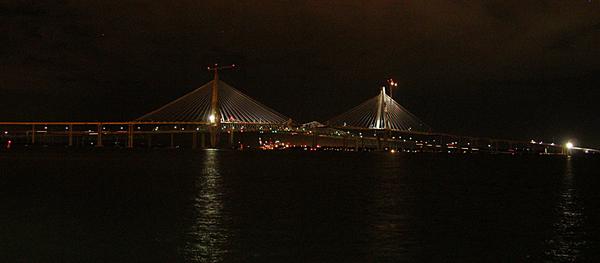Photo Adventures with Curiosity and Learning
Flat Abby visits Charleston, S.C.

Flat Abby arrived in Charleston, SC to visit us, Grandmother and Grandfather Starmer, in late October 2004, just in time for Halloween.

Charleston, one of the first cities settled in America, was established in 1670 as Charles Town. Its citizens played a major role in the Revolutionary War. Arthur Middleton, one of the four South Carolina signers of the Declaration of Independence was from Charleston. Francis Marion, called the Swamp Fox by the British for his ability to move his troops in and out of the South Carolina lowlands and attack them by surprise, was born just north of Charleston.
Charleston has a nice sheltered harbor and from its earliest times it was a center of trade. Rice and oranges were grown here for export. Cotton grown further inland was also exported in large quantities from Charleston. Up until the Civil War, which began in 1861, Charleston was also a major port of entry for slaves who were sold as laborers for the large cotton, rice, and indigo plantations alover the South.
Grandmother and Grandfather Starmer live in the kitchen house of a large historic house single house in Charleston called the Beauregard House. The Beauregard House was built around 1840 and is named after General Pierre Gustave Toutant(P.G.T.) Beauregard, a general for the Confederate States of America. It is said that General Beauregard used the house for his headquarters during the last years of the Civil War.

General P.G.T. Beauregard
On April 12, 1861, the Provisional Army of the Confederate States of America directed by General P.G.T. Beauregard, fired the opening shots of the Civil War on Union troops holding Fort Sumter, located in Charleston's Harbor.
Flat Abby is standing on the shore near Battery Park pointing to Fort Sumter. It is just a tiny speck in the distance. Below is a cannon that was used to fire on Fort Sumter.


Flat Abby and Grandmother walked around the Battery Park and Grandfather took their picture at the Confederate monument.


This is the Beauregard House. It is a typical Charleston single house built in the Greek Revival Style. The main house was lived in by a single family. Origionally it had two main floors and a large bedroom area and attic on the third floor. Windows on all four sides let the owners catch a glimpse of the Ashley River to the west, the Cooper River to the east and the ocean to the south. This house is built on “high” ground, 13 feet above sea level. During large storms Charleston often floods but this house was high enough above sea level that storage rooms could be built on the ground floor to store food and supplies. Today each floor houses a single family and the ground floor storage rooms have been made into apartments

Flat Abby explored the first floor piazza. Charlestonians call a porch a piazza.


At last we arrived at the kitchen house where Grandmother and Grandfather live. Before the Civil War, the owners of the house lived in the main house and theirslaves occupied the kitchen house and the carriage house. The slaves who lived in the kitchen house tended the main house and did the cooking, cleaning and laundry.

Those who lived in the carriage house, which is the brick building to the right of the kitchen house, tended the garden and the horses. They lived on the second floor and the horses stayed on the ground floor. Today a single family lives here and the ground floor is a part of their home.

Flat Abby went into the kitchen house.

Flat Abby got to explore the whole house, including the large cistern located right underneath Grandmother and Grandfather's kitchen. A cistern is not the same than as a well. A well is a shaft sunk into the ground to obtain ground water or spring water. A cistern is a large water storage vault underground which holds rainwater or water that has been pumped into it for storage. Gutters from the roof of the main house channeled water into the cistern whenever it rained. If it did not rain for a long time, the cistern could become empty. The Beauregard House cistern is quite large, perhaps the largest in Charleston. It is 20 feet long, 12 feet wide and 6 feet deep. It has four distinct arched chambers. The arches make it very strong, Slaves who did the cooking, cleaning and laundry hauled the water up from the cistern in buckets. Six years ago this cistern was drained and sealed so that there is no water in it now. It was very dark in the cistern but Flat Abby was not a bit frightened.

At last Flat Abby was ready for a rest. She sat in the garden with Grandmother and Grandfather. The weather is very pleasant in Charleston and she spent many happy hours there.



Charleston today is still a large port city and there are many cargo ships which pass through the harbor every day. Flat Abby saw many ships coming in and out of the port. She watched a tugboat slowly guide this large ship through the shipping channel to its dock so that it could unload its containers.

The city of Charleston is building a new bridge to span the Cooper and the Wando Rivers and connect the town of Mt. Pleasant with Charleston. It is not yet completed but it will be the largest cable stay bridge in North America. Flat Abby went to inspect the new bridge construction with Grandfather.

Grandfather has taken many pictures of this bridge construction. These workmen work high above the river as a team. Note the safety net.








This work is licensed under a Creative Commons License.
C. Frank Starmer